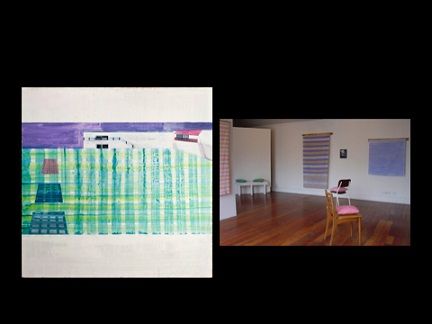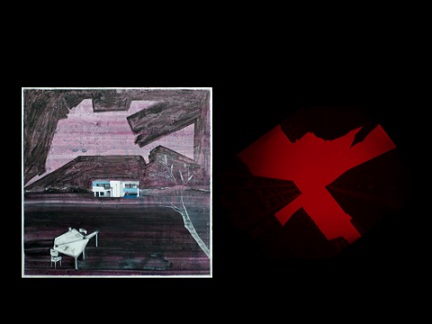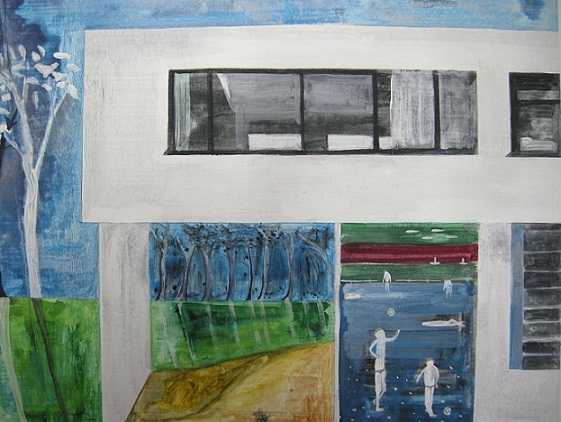藝評
Hong Kong’s Art Scene in Ten Years’ Time
約翰百德 (John BATTEN)
at 12:09pm on 19th December 2011




Captions:
1. Doris Wong Wai Yin’s residency project at Asia Art Archive “If You Have Money Build Hong Kong a Museum (2007-2008)”.
2. Doris Wong Wai Yin, LEE Kit Museum, Hong Kong Artist Museum Series, Acrylic on board, 2008.
3. Doris Wong Wai Yin, LEUNG Chi Wo Museum, Hong Kong Artist Museum Series, Acrylic on board, 2008.
4. Doris Wong Wai Yin, CHU Hing Wah Museum, Hong Kong Artist Museum Series, Acrylic on board, 2008.
(原文以英文發表,題為《十年後的香港藝壇情況》。)
Recently, the Dutch Chamber of Commerce asked me to write a few ideas about where Hong Kong’s art scene would be in ten years’ time. Here are some ideas:
In ten years’ time, Hong Kong will have the West Kowloon Cultural District built and thriving with people and we will be referring to it (hopefully!) by another name – artistically, there will be highs and lows. One of the lows is the constant bickering about the level of independence that the Museum has, as the government in 2011-2012 decided that the Museum (thankfully, no longer called M+) would have a majority of government officials sitting on its Board of Governors. Exhibition programming and funding problems will be constantly in the press as an effective and well-capitalised endowment foundation for art purchases and acquisitions had not adequately been set-up in 2012 and Hong Kong’s business tycoons continue to make their philanthropic donations to educational, rather than art, organisations.
The publicly funded spaces for contemporary art inside the Victoria Prison complex will be open and exhibiting the sort of shows that the rest of the world has long taken for granted. There have been demands that the parade ground be grassed so people can relax and temporary art and performances can be performed on grass rather than the concrete that was in place in 2011. After great community pressure the Hong Kong Museum of Art has evolved into a tighter operation, focussed only on Chinese traditional art and responsible to a nominally independent board of directors – its contemporary art collections have been transferred to the WKCD Museum and the old Heritage Museum (now renamed the Luis Chan Gallery – in honour of Hong Kong’s outstanding modernist).
Hong Kong commercial art galleries will remain located in Central and the industrial area of Kwai Hing. All businesses will be complaining that there is no cheap industrial spaces left for logistics, warehousing, food production, engineering, storage and related industries, because the government decided in 2011 to open these areas for office and residential uses. Similarly, artists will be housed in government-sponsored studios and will be complaining about many imposed restrictions and the high rents compared to their (2011) reasonably affordable studios in industrial buildings.
The money-laundering and fake art scandals of mainland art sold in Hong Kong auction houses will be headline news in 2015, fueling great cynicism and distrust towards the contemporary Chinese art market. Collectors will then focus on collecting the excellent art being done in Taiwan and Hong Kong, with a wider appreciation for contemporary Philippine, Thai and Indonesian art. Likewise, Hong Kong artists and the art scene will have greater access and synergy with Southeast Asia.
There will be a trend for wealthy art collectors to house their art collections in large industrial buildings or publicly owned heritage buildings under the legal umbrella of an art foundation and these collections will be on public display.
The work of Luis Chan and Cheung Yee will be reassessed and both will be honoured as major Asian modernists.
Disappointed by the conservative and restrictive art programming in most publicly funded art spaces, artists will open a range of artist-run spaces showing the latest film and conceptual art projects. The coffee shop and art magazine reading room at the Victoria Prison contemporary art gallery will be so good that it will be a Sunday meeting place for open discussions and activities – similar to the Stedelijk Museum in Amsterdam in 2011 and the basement café at London’s old Tate Gallery of the 1980s and early 1990s.
And, John Batten will be asked to write a short memoir recalling Hong Kong’s art scene of 2011!
1. Doris Wong Wai Yin’s residency project at Asia Art Archive “If You Have Money Build Hong Kong a Museum (2007-2008)”.
2. Doris Wong Wai Yin, LEE Kit Museum, Hong Kong Artist Museum Series, Acrylic on board, 2008.
3. Doris Wong Wai Yin, LEUNG Chi Wo Museum, Hong Kong Artist Museum Series, Acrylic on board, 2008.
4. Doris Wong Wai Yin, CHU Hing Wah Museum, Hong Kong Artist Museum Series, Acrylic on board, 2008.
(原文以英文發表,題為《十年後的香港藝壇情況》。)
Recently, the Dutch Chamber of Commerce asked me to write a few ideas about where Hong Kong’s art scene would be in ten years’ time. Here are some ideas:
In ten years’ time, Hong Kong will have the West Kowloon Cultural District built and thriving with people and we will be referring to it (hopefully!) by another name – artistically, there will be highs and lows. One of the lows is the constant bickering about the level of independence that the Museum has, as the government in 2011-2012 decided that the Museum (thankfully, no longer called M+) would have a majority of government officials sitting on its Board of Governors. Exhibition programming and funding problems will be constantly in the press as an effective and well-capitalised endowment foundation for art purchases and acquisitions had not adequately been set-up in 2012 and Hong Kong’s business tycoons continue to make their philanthropic donations to educational, rather than art, organisations.
The publicly funded spaces for contemporary art inside the Victoria Prison complex will be open and exhibiting the sort of shows that the rest of the world has long taken for granted. There have been demands that the parade ground be grassed so people can relax and temporary art and performances can be performed on grass rather than the concrete that was in place in 2011. After great community pressure the Hong Kong Museum of Art has evolved into a tighter operation, focussed only on Chinese traditional art and responsible to a nominally independent board of directors – its contemporary art collections have been transferred to the WKCD Museum and the old Heritage Museum (now renamed the Luis Chan Gallery – in honour of Hong Kong’s outstanding modernist).
Hong Kong commercial art galleries will remain located in Central and the industrial area of Kwai Hing. All businesses will be complaining that there is no cheap industrial spaces left for logistics, warehousing, food production, engineering, storage and related industries, because the government decided in 2011 to open these areas for office and residential uses. Similarly, artists will be housed in government-sponsored studios and will be complaining about many imposed restrictions and the high rents compared to their (2011) reasonably affordable studios in industrial buildings.
The money-laundering and fake art scandals of mainland art sold in Hong Kong auction houses will be headline news in 2015, fueling great cynicism and distrust towards the contemporary Chinese art market. Collectors will then focus on collecting the excellent art being done in Taiwan and Hong Kong, with a wider appreciation for contemporary Philippine, Thai and Indonesian art. Likewise, Hong Kong artists and the art scene will have greater access and synergy with Southeast Asia.
There will be a trend for wealthy art collectors to house their art collections in large industrial buildings or publicly owned heritage buildings under the legal umbrella of an art foundation and these collections will be on public display.
The work of Luis Chan and Cheung Yee will be reassessed and both will be honoured as major Asian modernists.
Disappointed by the conservative and restrictive art programming in most publicly funded art spaces, artists will open a range of artist-run spaces showing the latest film and conceptual art projects. The coffee shop and art magazine reading room at the Victoria Prison contemporary art gallery will be so good that it will be a Sunday meeting place for open discussions and activities – similar to the Stedelijk Museum in Amsterdam in 2011 and the basement café at London’s old Tate Gallery of the 1980s and early 1990s.
And, John Batten will be asked to write a short memoir recalling Hong Kong’s art scene of 2011!
